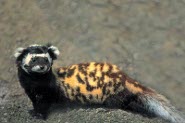 The small mammal, theMarbled Polecat (Vormela peregusna), belongs to the monotypic genus Vormela and is a member of Mustelinae subfamily. The word 'Vormela' comes from the German word 'Würmlein' depicting the size of the marbled polecat. The word 'Peregusna' has come from 'pereguznya', the Ukrainian word for 'polecat'. Marbled polecats can be found in the grasslands and dry areas of western China to the southern-eastern regions of Europe. When threatened, the anal sacs under its tail emit a secretion with a very strong smell.
The small mammal, theMarbled Polecat (Vormela peregusna), belongs to the monotypic genus Vormela and is a member of Mustelinae subfamily. The word 'Vormela' comes from the German word 'Würmlein' depicting the size of the marbled polecat. The word 'Peregusna' has come from 'pereguznya', the Ukrainian word for 'polecat'. Marbled polecats can be found in the grasslands and dry areas of western China to the southern-eastern regions of Europe. When threatened, the anal sacs under its tail emit a secretion with a very strong smell.The length of the polecat is generally between 29 and 35 cm. It has short limbs, short muzzle, very large ears, and long but strong claws. The polecat has a short structure as compared to its long, hairy tail. The face has black and white marks on it. There are black stripes across its eyes and white markings on its face. The other species of this family dorsally is yellow in color and there are brown and reddish spots all over its body. The color of the tail is dark brown and in the middle of the tai,l there is a yellowish band. The weight of the female polecat is generally 295g to 600g and the male polecat weighs about 320g to 715g.
The marbled polecat is generally found in China, Russia, and south-east Europe.
Marbled polecats are very active during the morning and the evening times. Since their eyesight is weak, their movement depends a lot on their powerful sense of smell. Their vocalization is quite limited and usually consists of shrill grunts, submissive long shrieks, and alarm cries. By nature, they prefer being alone and move in a radius of about 0.5 - 0.6 km from their homes. They generally do not stay at one place for more than once and are quite aggressive when encountering with other polecats.
When they sense any kind of danger, marbled polecats lift their legs, while at the same time, arch their back and curl their tail on their back with their long tail hair standing erect. They also given short, shrill hisses, cover their teeth, and lift their head. When threatened, marbled polecats sometimes release an extremely foul smell from their inflated anal glands located under the tail.
When digging or excavating dens, marbled polecats use their forelegs to dig the earth and anchor themselves using their hind legs and chin. They make use of their teeth to weed off obstacles like roots and grass while digging.
Marbled polecats generally feed on ground squirrels, Armenian hamsters, mole rats, voles, Libyan jirds, frogs, lizards, hares, fish, birds, pigeons, chickens, house mice, and insects such as crickets, beetles, snails, and so on. They have also been found to stealing cheese and smoked meat in houses.
Picture of the marbled polecat, Courtesy of Photographer: Laszlo Szabo-Szeley ©AVESTOURS
Keywords: tail
The Marbled polecat is listed as Least Concern (LR/lc), lowest risk. Does not qualify for a more at risk category. Widespread and abundant taxa are included in this category, on the IUCN Red List of Threatened Species
Namings for the marbled polecat
A young / baby of a marbled polecat is called a 'kit'. The females are called 'jill' and males 'hob'. A marbled polecat group is called a 'chine'.Countries
Afghanistan, Armenia, Azerbaijan, Bulgaria, China, Georgia, Greece, Iran, Iraq, Israel, Kazakhstan, Lebanon, Macedonia, Mongolia, Pakistan, Romania, Russia, Serbia and Montenegro, Syria, Turkey, Turkmenistan, Ukraine and UzbekistanSome facts about the
Marbled polecat
Adult weight : 0.543 kg (1.1946 lbs)
Maximum longevity : 9 years
Female maturity :91 days
Gestation : 61 days
Weaning : 30 days
Litter size : 6

Custom Search